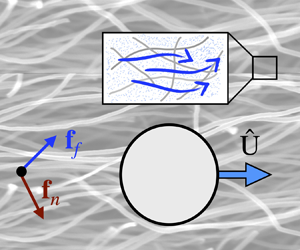Article contents
A reciprocal theorem for biphasic poro-viscoelastic materials
Published online by Cambridge University Press: 17 October 2024
Abstract

In studying the transport of inclusions in multiphase systems we are often interested in integrated quantities such as the net force and the net velocity of the inclusions. In the reciprocal theorem the known solution to the first and typically easier boundary value problem is used to compute the integrated quantities, such as the net force, in the second problem without the need to solve that problem. Here, we derive a reciprocal theorem for poro-viscoelastic (or biphasic) materials that are composed of a linear compressible solid phase, permeated by a viscous fluid. As an example, we analytically calculate the time-dependent net force on a rigid sphere in response to point forces applied to the elastic network and the Newtonian fluid phases of the biphasic material. We show that when the point force is applied to the fluid phase, the net force on the sphere evolves over time scales that are independent of the distance between the point force and the sphere; in comparison, when the point force is applied to the elastic phase, the time scale for force development increases quadratically with the distance, in line with the scaling of poroelastic relaxation time. Finally, we formulate and discuss how the reciprocal theorem can be applied to other areas, including (i) calculating the network slip on the sphere's surface, (ii) computing the leading-order effects of nonlinearities in the fluid and network forces and stresses, and (iii) calculating self-propulsion in biphasic systems.
- Type
- JFM Papers
- Information
- Copyright
- © The Author(s), 2024. Published by Cambridge University Press
References
- 1
- Cited by



